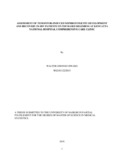| dc.contributor.author | Owako, Walter O | |
| dc.date.accessioned | 2019-01-14T09:51:01Z | |
| dc.date.available | 2019-01-14T09:51:01Z | |
| dc.date.issued | 2018 | |
| dc.identifier.uri | http://hdl.handle.net/11295/104611 | |
| dc.description.abstract | Background: TDF containing HAART is currently the most approved global HIV first-line treatment. Despite its accessibility as a mixture single-tablet regimen for once daily dosing, favorable safety profile and resistance, and effective antiviral activity, it is associated with renal impairment among patients with concurrent use of protease inhibitors and those with advanced HIV virus. Several studies have been done investigating the risk factors for occurrence of kidney disease among HIV positive patients on TDF regimens but few have specifically investigated the time to recovery from this disease.
Objective: To assess Tenofovir-induced nephrotoxicity development and recovery among patients on TDF based regimen at KNH CCC between 2010 and 2015.
Study design and study population: The study was retrospective cohort that used HIV care follow-up data for patients (n≥528) started on TDF based regimens between 2009 and 2012. Information on the baseline distinctiveness of the patients at start of treatment and dates of change of regimen for patients that developed Tenofovir-induced nephrotoxicity was collected from the database using a structured data collection tool.
Data analysis: The two outcomes of interest were the time to development and time to recovery from Tenofovir-induced nephrotoxicity. Conditional Presmoothed Kaplan-Meier Weighted estimator was used to estimate the survival functions (time to development & recovery). Multivariate Log-rank test was utilized to evaluate the endurance functions based on the three TDF based regimens. Conditional risk set model was used to evaluate prognostic factors for time to recovery TDF-induced nephrotoxicity adjusted for time to diagnosis.
10
Results: Of the 534 patients were followed 324 were diagnosed with TDF-induced nephrotoxicity with only 88 reported to have been recovered. The median time to diagnosis was estimated at 43.7months after initiation of ART (IQR=24.3-59.9 months); three quarters had recovered by the 16th month upon withdrawal of TDF. Patient gender (Male-HR=0.68, P-value=0.013), age group (Adults-HR=0.66, P-value=0.029) and ALT/GPT levels (HR=1.01, P-value=0.044) were found to significantly affect the expected hazard of patient recovery.
Conclusion: Prolonged use of TDF in first line ART regimen is associated with nephrotoxicity which is reversible upon withdrawal. Males and older patients are at a high risk of taking longer to recover from the disease once diagnosed. Regular monitoring of creatinine authorization during follow-up with TDF uses is paramount to prevent nephrotoxicity especially in this high-risk group of patients. | en_US |
| dc.language.iso | en | en_US |
| dc.publisher | University of Nairobi | en_US |
| dc.rights | Attribution-NonCommercial-NoDerivs 3.0 United States | * |
| dc.rights.uri | http://creativecommons.org/licenses/by-nc-nd/3.0/us/ | * |
| dc.title | Assessment of tenofovir-induced nephrotoxicity development and recovery in HIV patients on TDF based regimens at Kenyatta National Hospital comprehensive care clinic | en_US |
| dc.type | Thesis | en_US |
| dc.description.department | a
Department of Psychiatry, University of Nairobi, ; bDepartment of Mental Health, School of Medicine,
Moi University, Eldoret, Kenya | |



